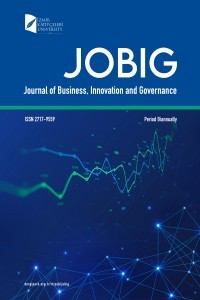İLLER ARASI EKONOMİK BÜYÜME YAKINSAMASINA ETKİ EDEN FAKTÖRLER
Bölgeler arası gelişmişlik farklılıklarının giderilmesi hem sürdürülebilir kalkınma hem de sosyal adalet yönünden önde gelen amaçlardan birisini oluşturmaktadır. Neo-klasik iktisat teorilerine göre belli varsayımlar altında iktisadi süreçler kendiliğinden gelir farklılıklarının kapanacağını iddia etmiş, ancak ülkeler arası heterojen yapılar ampirik çalışmalarda durumun böyle olmadığını göstermiştir. Yeni büyüme teorilerine ise yakınsama ancak belli koşullar altında ve benzer bölgeler arasında gerçekleşebilir bir olgudur. Bu çalışmada 2004-2017 yılları arasında Türkiye’de 81 il arasında bir yakınsama olup olmadığı test edilmiştir. Elde edilen ampirik bulgulara göre söz konusu dönem içinde yakınsama hipotezi geçerlidir. Yani, göreceli olarak zengin bölgeler, daha az zengin bölgelere göre daha düşük hızla büyümektedirler. Bu sürecin devamı durumunda uzun dönem durağan durumda bölgelerin gelirlerini eşitlenmesi beklenir. Ayrıca ekonomik büyümeye etki eden başlıca faktör olarak dış ticaret ve kadınların okur-yazarlık oranı bulunmuş, kamu harcamalarının, iç göçün, okullaşma oranının ve suç oranlarının ise bir etkisi bulunamamıştır.
Anahtar Kelimeler:
Ekonomik büyüme, yakınsama, eğitim, teknoloji
ECONOMIC CONVERGENCE AMONG THE PROVINCES IN TURKEY AND DETERMINANT FACTORS
Regional economic convergence is one of the main aims of economic and social policy in order to attain sustainable development. Neo-classical economic theories claim that the gap in income levels among different regions/countries eventually disappear under certain assumptions. However, the empirical findings in the literature do not confirm this hypothesis as regions show heterogenous structures. New growth theories claim that convergence is only valid among homogenous regions under certain conditions. In this study I analyse 81 provinces between 2004-2017 period in order to test the convergence hypothesis for Turkish provinces. According to our findings, the convergence hypothesis holds true for our sample. Furthermore we also find that foreign trade and female literacy are important factors for growth. Our results also fail to find significant impacts of government expenditures, crime and migration
Keywords:
economic growth, convergence, education, technology,
___
- Abdioğlu, Z. &T. Uysal (2013), “Türkiye’de Bölgeler Arası Yakınsama: Panel Birim Kök Analizi”, Atatürk Üniversitesi İktisadi ve İdari Bilimler Dergisi, 27(3), 125-143.
- Abramovitz, M. (1986). “Catching Up, Forging Ahead, and Falling Behind,” The Journal of Economic History, 46, 385-406.
- Altınbaş, S., Doğruel, F. & Güneş, M. (2002). Türkiye’de Bölgesel Yakınsama: Kalkınmada öncelikli iller politikası başarılı mı? VI. ODTÜ Uluslararası Ekonomi Kongresi, 1-21.
- Arellano, Manuel and Bond, Stephen (1991) “Some Tests of Specification for Panel Data: Monte Carlo Evidence and an Application to Employment Equations”, The Review of Economic Studies, Volume 58, Issue 2, April 1991, Pages 277–297
- Barro, R.J. (1991). “Economic Growth in a Cross-Section of Countries,” Quarterly Journal of Economics, 106, 407-443.
- Barro, R.J. and X. Sala-i-Martin. (1992). “Convergence,” Journal of Political Economy, 100, 223-251.
- Barro, R.J. and X. Sala-i-Martin. (1995). Economic Growth, McGraw-Hill.
- Berber, M., Yamak, R. ve Artan, S. (2000). Türkiye’de Yakınlaşma Hipotezinin Bölgeler Arasında Geçerliliği Üzerine Ampirik Bir Çalışma: 1975-1997. 9. Ulusal Bölge Bilimi ve Bölge Planlama Kongresi Bildiriler Kitabı: 51-59.
- Chatterji, M. (1992). “Convergence and Growth Amongst Rich and Poor,” Working Paper, Economics Department, Vassar College.
- Dowrick, S. (2004). “Income-based Measures of Average Well-being,” Working Paper Series UNU-WIDER Research Paper, World Institute for Development Economic Research (UNU-WIDER). Durlauf, S.N. and P.A. Johnson. (1995). “Multiple Regimes and Cross-Country Growth Behavior,” Journal of Applied Econometrics, 10, 365-284.
- Erk, N., Ateş, S. and Direkçi, T. (2000). Convergence and Growth Within GAP Region (South Eastern Anatolia Project) and Overall Turkey’s Regions. IV. ODTÜ Uluslararası Ekonomi Kongresi, Ankara.
- Filiztekin, A. (1998), ‘Convergence Across Industries and Provinces in Turkey’, Koç University Working Paper Series, Sayı 1998/08.
- Gerni, Cevat, Selahattin Sarı, Haktan Sevinç, ve Ömer Selçuk Emsen. 2015. Bölgesel Dengesizliklerin Giderilmesinde Yatırım Teşviklerinin Rolü ve Başarı Kriteri Olarak Yakınsama Analizleri: Türkiye Örneği. In Proceedings of the International Conference on Eurasian Economies, Kazan, Russia, 9–11 September 2015.
- Gömleksiz, M, Sahbaz, A ve Mercan, B. (2017) “Regional Economic Convergence in Turkey: Does the Government Really Matter for?” Economies 2017, 5(3), 27.
- Grier, K. and G. Tullock. (1989). “An Empirical Analysis of Cross-national Economic Growth, 1951-1980,” Journal of Monetary Economics, 24, 259-276.
- Islam, N. (1995). Growth Empirics: A Panel Data Approach. The Quarterly Journal of Economics, 110(4), 1127-1170.
- Mankiw, N.G., D. Romer, and D.N. Weil. (1992). “A Contribution to the Empirics of Economic Growth,” The Quarterly Journal of Economics, 107, 407-437.
- Önder A. Özlem, Ertuğrul Deliktaş & Metin Karadağ (2010) “The Impact of Public Capital Stock on Regional Convergence in Turkey”, European Planning Studies, 18:7, 1041-1055.
- Rodrik, D. (2013). “Unconditional Convergence in Manufacturing,” Quarterly Journal of Economics, 128, 165-204.
- Sachs, Jeffrey D. and Andrew Warner (1995), “Economic Reform and the Process of Global Integration”, Brookings Papers on Economic Activity, no. 1, pp. 1-118.
- Sağbaş, İsa. 2002. Türkiye’de Kamu Harcamalarının Yakınsama Üzerindeki Etkisi. Afyon Kocatepe Üniversitesi İ.İ.B.F. Dergisi 4: 137–48.
- Tan, C.M. (2010). “No One True Path to Development: Uncovering The Interplay Between Geography, Institutions and Ethnic Fractionalization in Economic Development,” Journal of Applied Econometrics, 25, 1100-1127.
- Tansel, A. ve Güngör, N.D. (1998), “Economic Growth and Convergence: An Application to the Provinces of Turkey, 1975-1995”, ERC Working Paper No.98/9, Economic Research Center, Middle East Technical University.
- Wolff, E., & Baumol, W. (1988). Productivity growth, convergence, and welfare. American Economic Review, 78(5).
- Yamanoğlu, K.B. (2008), “Türkiye’de Sosyo-Ekonomik Faktörlerin İller Arası Yakınsama Üzerine Etkileri”, İstatistikçiler Dergisi, 1(1), 33-49.
- Yayın Aralığı: Yılda 2 Sayı
- Başlangıç: 2018
- Yayıncı: İzmir Katip Çelebi Üniversitesi
Sayıdaki Diğer Makaleler
SANAYİ 4.0 ve TEKNOLOJİ BİLEŞENLERİ
VIB: BİR PAZARLAMA VAKA ÇALIŞMASI ANALİZİ
Kemal KURTULUŞ, Cem KARAYALÇIN
İLLER ARASI EKONOMİK BÜYÜME YAKINSAMASINA ETKİ EDEN FAKTÖRLER
CİNSİYET EŞİTSİZLİĞİ VE ULUSLARARASI FİNANSAL İLİŞKİLER: NİCELİKSEL BİR DEĞERLENDİRME
ÇALIŞANLARIN PERFORMANS DEĞERLENDİRMELERİNİN İNSAN KAYNAKLARI BAKIŞ AÇISIYLA ELE ALINMASI
